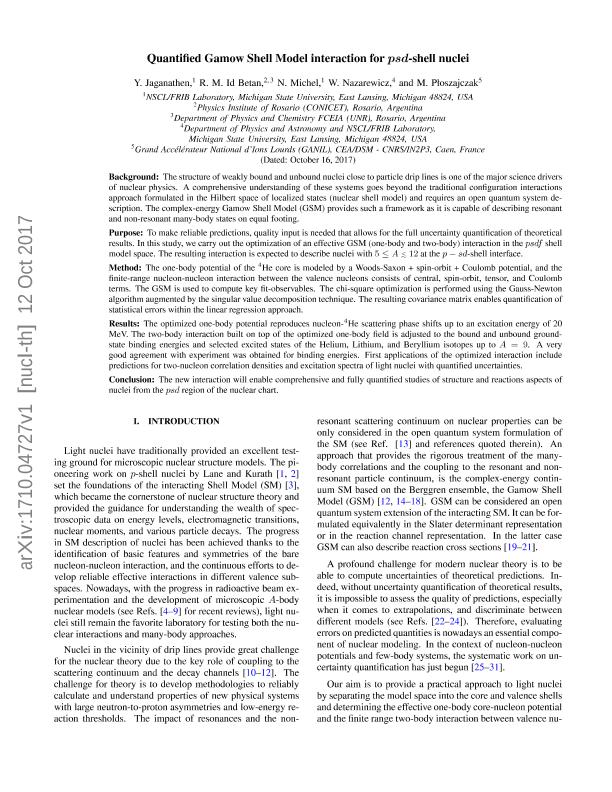Mostrar el registro sencillo del ítem
dc.contributor.author
Jaganathen, Y.
dc.contributor.author
Id Betan, Rodolfo Mohamed

dc.contributor.author
Michel, N.
dc.contributor.author
Nazarewicz, W.
dc.contributor.author
Ploszajczak, M.
dc.date.available
2018-11-09T20:03:41Z
dc.date.issued
2017-11
dc.identifier.citation
Jaganathen, Y.; Id Betan, Rodolfo Mohamed; Michel, N.; Nazarewicz, W.; Ploszajczak, M.; Quantified Gamow shell model interaction for psd -shell nuclei; American Physical Society; Physical Review C; 96; 5; 11-2017; 1-11
dc.identifier.issn
2469-9993
dc.identifier.uri
http://hdl.handle.net/11336/64145
dc.description.abstract
Background: The structure of weakly bound and unbound nuclei close to particle drip lines is one of the major science drivers of nuclear physics. A comprehensive understanding of these systems goes beyond the traditional configuration interaction approach formulated in the Hilbert space of localized states (nuclear shell model) and requires an open quantum system description. The complex-energy Gamow shell model (GSM) provides such a framework as it is capable of describing resonant and nonresonant many-body states on equal footing. Purpose: To make reliable predictions, quality input is needed that allows for the full uncertainty quantification of theoretical results. In this study, we carry out the optimization of an effective GSM (one-body and two-body) interaction in the psdf-shell-model space. The resulting interaction is expected to describe nuclei with 512 at the p-sd-shell interface. Method: The one-body potential of the He4 core is modeled by a Woods-Saxon + spin-orbit + Coulomb potential, and the finite-range nucleon-nucleon interaction between the valence nucleons consists of central, spin-orbit, tensor, and Coulomb terms. The GSM is used to compute key fit observables. The χ2 optimization is performed using the Gauss-Newton algorithm augmented by the singular value decomposition technique. The resulting covariance matrix enables quantification of statistical errors within the linear regression approach. Results: The optimized one-body potential reproduces nucleon-He4 scattering phase shifts up to an excitation energy of 20 MeV. The two-body interaction built on top of the optimized one-body field is adjusted to the bound and unbound ground-state binding energies and selected excited states of the helium, lithium, and beryllium isotopes up to A=9. A very good agreement with experimental results was obtained for binding energies. First applications of the optimized interaction include predictions for two-nucleon correlation densities and excitation spectra of light nuclei with quantified uncertainties. Conclusion: The new interaction will enable comprehensive and fully quantified studies of structure and reactions aspects of nuclei from the psd region of the nuclear chart.
dc.format
application/pdf
dc.language.iso
eng
dc.publisher
American Physical Society

dc.rights
info:eu-repo/semantics/openAccess
dc.rights.uri
https://creativecommons.org/licenses/by-nc-sa/2.5/ar/
dc.subject
Gamow
dc.subject
Effective Interaction
dc.subject
Berggren
dc.subject
Continuum
dc.subject.classification
Otras Ciencias Físicas

dc.subject.classification
Ciencias Físicas

dc.subject.classification
CIENCIAS NATURALES Y EXACTAS

dc.title
Quantified Gamow shell model interaction for psd -shell nuclei
dc.type
info:eu-repo/semantics/article
dc.type
info:ar-repo/semantics/artículo
dc.type
info:eu-repo/semantics/publishedVersion
dc.date.updated
2018-10-23T16:35:49Z
dc.journal.volume
96
dc.journal.number
5
dc.journal.pagination
1-11
dc.journal.pais
Estados Unidos

dc.description.fil
Fil: Jaganathen, Y.. Michigan State University; Estados Unidos
dc.description.fil
Fil: Id Betan, Rodolfo Mohamed. Consejo Nacional de Investigaciones Científicas y Técnicas. Centro Científico Tecnológico Conicet - Rosario. Instituto de Física de Rosario. Universidad Nacional de Rosario. Instituto de Física de Rosario; Argentina
dc.description.fil
Fil: Michel, N.. Michigan State University; Estados Unidos
dc.description.fil
Fil: Nazarewicz, W.. Michigan State University; Estados Unidos
dc.description.fil
Fil: Ploszajczak, M.. Grand Accelérateur National d’Ions Lourds; Francia
dc.journal.title
Physical Review C
dc.relation.alternativeid
info:eu-repo/semantics/altIdentifier/doi/http://dx.doi.org/10.1103/PhysRevC.96.054316
dc.relation.alternativeid
info:eu-repo/semantics/altIdentifier/url/https://journals.aps.org/prc/abstract/10.1103/PhysRevC.96.054316
Archivos asociados
